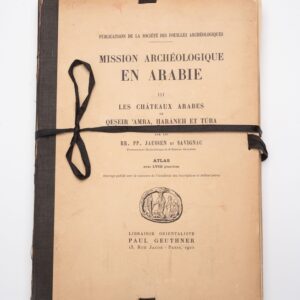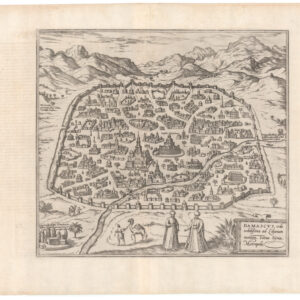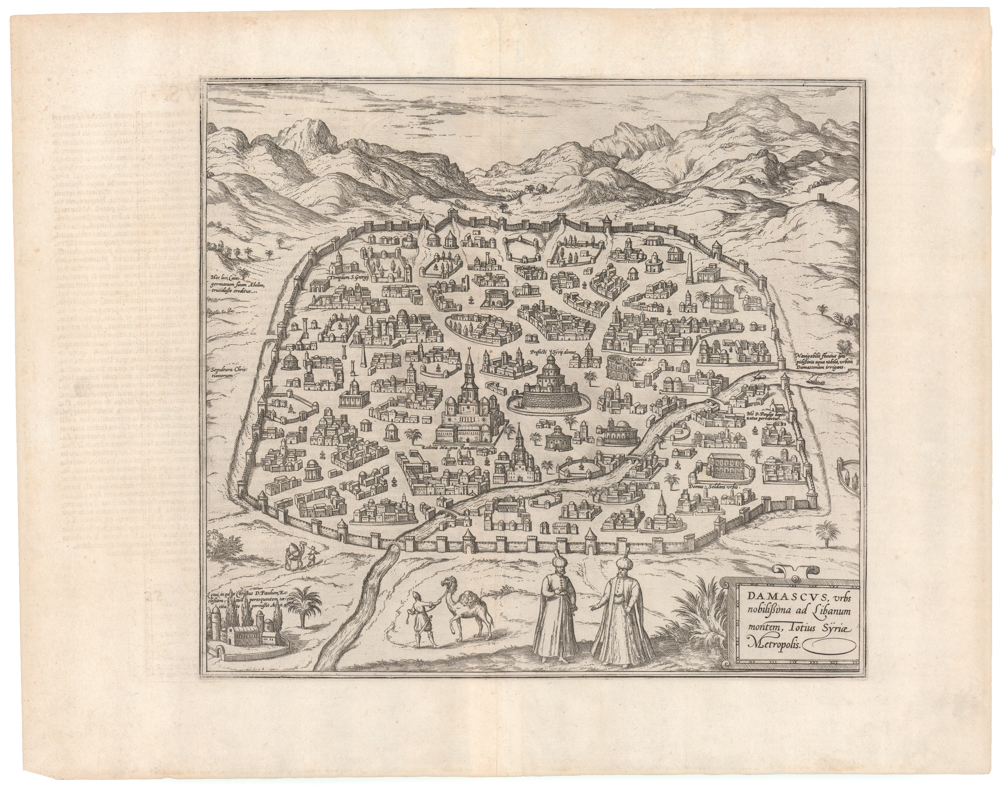Briet’s illuminating map of the Holy Land.
Palestinae delineatio ad geographiae canones revocata.
$975
1 in stock
Description
Philippe Briet’s 1641 map, Palestinae delineatio ad geographiae canones revocata, is a rare and meticulously crafted depiction of the Holy Land, produced in accordance with the most advanced cartographic principles of its time.
The main map, occupying the lower portion of the sheet, presents ancient Palestine oriented with the east at the top, a common convention in early biblical cartography. This alignment positions the Mediterranean Sea (Mare Magnum) along the bottom edge, creating an inversion that encourages contemplation of the region from a spiritual, rather than strictly geographical, perspective. The Holy Land is carefully subdivided into the territories of the twelve tribes of Israel, extending from Sidon in the north to Rhinocolura (modern-day El-Arish in Egypt) in the south, and encompassing both sides of the Jordan River.
Above the principal map, three inset panels provide complementary historical and theological views. On the upper left, Syriae veteris descriptio maps ancient Syria according to classical sources, offering a wider geographical context of the Eastern Mediterranean and Near East. At the center, a detailed plan of ancient Jerusalem (Hierusalem) reconstructs the city as it was believed to appear during the Roman era, reflecting both religious tradition and contemporary archaeological interpretation. On the upper right, Exodus Israelis traces the biblical journey of the Israelites from Ramses in Egypt, across the Red Sea and the Sinai Peninsula, to their arrival in the Promised Land, following the Old Testament narrative.
Briet’s innovation lies not only in his subdivision of the Holy Land into tribal territories—an uncommon feature in maps of the time—but also in his fusion of classical geography with sacred history, creating a cartographic tableau that served both educational and devotional purposes.
A product of Jesuit scholarship, this map exemplifies a new paradigm in 17th-century cartography: one that sought not merely to describe the physical world, but to illuminate the spiritual and historical dimensions embedded within the land itself. Palestinae delineatio is thus more than a geographic document—it is a visual theology, rendered in ink and imagination.
Census
This map was part of Briet’s more extensive work, Parallela Geographiae Veteris et Novae, a three-volume historical atlas published between 1641 and 1649 that juxtaposed ancient and contemporary geographic knowledge.
Notably, Briet’s maps were engraved by Henri Le Roy. This specific version bears the imprint of the publisher Pierre Mariette, implying that it is the second state of this map (Michel van Lochom published the rarer first state). From 1650 onwards, the map was sometimes included in the atlases of Nicholas Sanson, who shared a close working relationship with Pierre Mariette.
The OCLC lists several institutional copies, many of which have been recorded under distinct identifiers (e.g., 494957632, 868853167, 494949941, 801694085, 837646542).
Context is Everything
When Palestinae delineatio… was published in 1641, Europe was gripped by a surge of intellectual and religious fascination with the Holy Land—a movement largely fueled by the rise of Jesuit scholarship and education. As a key figure in the new cartographic-humanist paradigm, Philippe Briet sought to employ geographical precision to illuminate the sacred narratives of Christianity. His map reflects the broader intellectual climate of 17th-century France, where scholars increasingly sought to merge historical inquiry, religious devotion, and geographic science. The goal was not merely to map territory, but to animate Scripture through space, making the ancient world intelligible and spiritually resonant for contemporary readers.
Cartographer(s):
Henri Le Roy was a French engraver active in the early 17th century. He specialized in architectural and ornamental etchings. His exact birth and death dates are not documented, but he is believed to have been born around 1579 and was active until at least 1651. Le Roy created intricate designs highlighting the Renaissance and Baroque styles that were prevalent during his lifetime. His works include decorative friezes and architectural motifs, which were in demand for their aesthetic appeal and craftsmanship. One of his known pieces, Frieze with Birds, is housed in the Metropolitan Museum of Art and demonstrates his skill with ornamental themes—depicting birds in a stylized, elongated frieze that illustrates the popular motifs of his period.
Le Roy’s engravings were notable for their clarity and precision, and he was often commissioned to decorate books and architectural plans. His name frequently appeared on plates as “Henri Le Roy excu,” indicating that he was both an artist and publisher, a common practice among engravers of that period. His works were collected and admired throughout France and beyond, contributing to his reputation as a skilled and versatile artist of engravings and etchings in decorative arts collections worldwide.
Philippe BrietPhilippe Briet (1601–1668) was a French Jesuit priest, historian, and cartographer based in Abbeville, France. Known for his meticulous historical and Biblical cartography work, Briet created numerous maps that integrated contemporary and classical geographic knowledge. His most notable publication, Parallela Geographica, released in 1649, featured a collection of maps comparing ancient and modern European geography, focusing on regions such as Sarmatia and encompassing parts of Eastern Europe, including Ukraine, Poland, and Lithuania. This ambitious atlas intended to juxtapose old and new geographies, reflecting Briet’s insistence that history could and should traced cartographically.
Briet continued to expand his work with other cartographic projects, including the Theatrum Geographiae Veteris, an atlas of Europe’s ancient regions, and Theatre Geographique de l’Europe in 1653, a detailed volume that mapped European countries and their provinces. Although he initially aimed to cover all continents, only his work on Europe was published, as his manuscript on Asia never reached publication. He collaborated with notable Parisian publishers like Pierre Mariette, contributing to the era’s development of high-quality geographic atlases and engravings.
Pierre MariettePierre Mariette I (1569–1657) was an influential French publisher and engraver recognized for developing French cartography and publishing during the early 17th century. Initially, Mariette focused on publishing art prints but pivoted to cartography after purchasing map plates from Melchior Tavernier in 1644. He partnered with Nicolas Sanson, a foundational figure in French cartography, to produce detailed folio maps and atlases. In this collaboration, Sanson provided geographic expertise and map designs, while Mariette managed engraving, printing, and distribution. Their maps often included both their imprints, reflecting their partnership’s close, interdependent nature.
Mariette’s legacy extended beyond his lifetime, though disputes over rights to the plates emerged between Sanson and Mariette’s heirs after Mariette’s death. A legal settlement in 1674 allocated most plates to Sanson’s family, leading to a mixture of attributions in later editions of the maps. Pierre Mariette’s contributions laid the groundwork for the Mariette family, who continued to impact French publishing and mapmaking well into the 18th century, establishing the Mariette name as synonymous with high-quality cartographic and artistic publishing in France.
Condition Description
Very good.
References



![[Unusual Jerusalem engraving / proof]](https://neatlinemaps.com/wp-content/uploads/2025/06/NL-02380_thumbnail-300x300.jpg)
![[Mısır Haritası / Map of Egypt]](https://neatlinemaps.com/wp-content/uploads/2025/06/NL-02391_thumbnail-2-300x300.jpg)